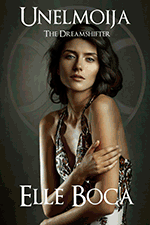Luxury Travel Review

Bald eagle safaris in Quad Cities, United States
By Chester Godsy
Photos by Chester Godsy and Joni Johnson-Godsy

Bob Motz of Bald Eagle Safaris
While visiting the Quad Cities we met with naturalist Bob Motz who offers local Bald Eagle Safaris. Bob filled us in on many of the interesting facts about eagles on our drive to an eagle viewing location. He told us he had a number of locations where he would take customers depending on their interests. Our interest on this trip was to get some pictures of eagles and to stay out of the cold weather as much as possible as temperatures were below 0 degrees Fahrenheit.

Eagles roosting
Bob provided us with some top notch spotting scopes that would go from x15 to x45 magnification and a training session on how to use them. When we arrived at the location he had selected we saw, spread across numerous trees, about two dozen eagles. There was a mixture of fully mature eagles (these could be identified by their white heads) and juvenile eagles (under five years of age). We watched the eagles with the spotting scopes and took pictures from the warmth of Bob’s car. We were between 25 and 75 yards from the eagles at all times.

Eagle in flight
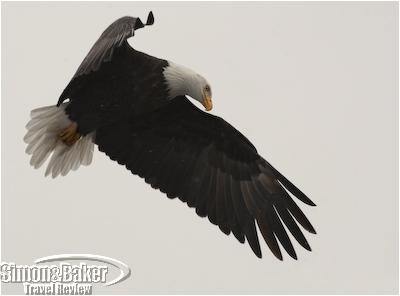
Coming in for a landing
On more than one occasion I had an eagle in full view with a spotting scope where I could clearly see the yellow eye of the eagle blinking. After our time with Bob we were really glad we started our eagle viewing with Bob’s Eagle Safaris (Eagle Safaris by Bob Motz, 2535 River Heights Drive, Rock Island, Illinois 61201, +1 (309) 788-8389, eaglemotz@aol.com) because of all we learned about the eagles before setting off to try eagle viewing by ourselves.
Place de la Concorde luxury hotel, gourmet restaurant among our Paris favorites
By Elena del Valle
Photos by Gary Cox
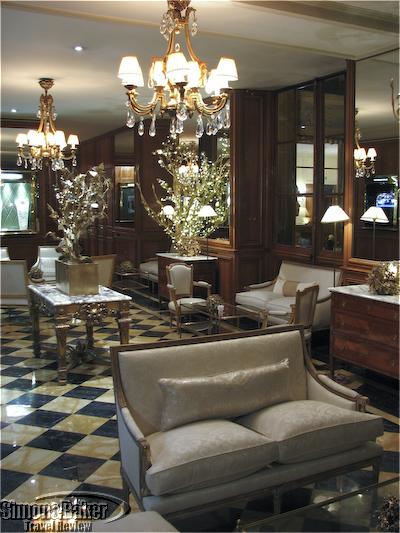
The common areas in Hotel de Crillon
Location, location, location. There is much truth to the saying in a city like Paris, France. Being in a good neighborhood means easy access to many of the attractions that make Paris one of the most alluring cities in the world.
From a tourist perspective the Place de la Concorde is a great location. While the Place itself is attractive it offers the added advantage that within walking distance or a short taxi ride from the Place there are many tourist points of interest like Tuilleries Gardens, Rue de Rivoli, Louvre Museum, Place Vendome, Place de la Madeleine and Champs Elysees Avenue as well as shopping venues and gourmet restaurants.
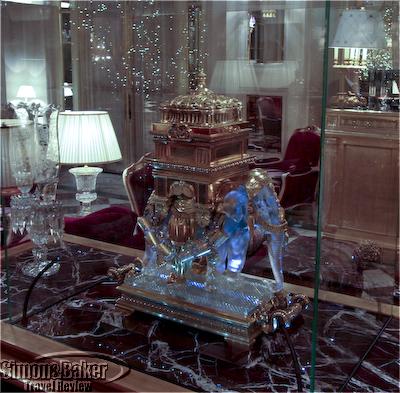
The Baccarat crystal elephant in the salon outside Les Ambassadeurs
On the Place, the Hotel de Crillon, part of a project commissioned in 1758 by Louis XV, became a private residence and was converted to a hotel in 1909. Over time the hotel has been the temporary home of United States Presidents Herbert Hoover, Theodore Roosevelt and Richard Nixon, Emperor Hirohito of Japan, Reza Shah Pahlavi of Iran, King George V of England, King Juan Carlos and the queen of Spain, Madonna, and Elizabeth Taylor among others. The historic building is to this day a luxury hotel. We stayed there during a holiday trip to the City of Lights.
For those who need to combine business with pleasure the hotel, located across the street from the United States Embassy, is in central Paris. Although the facade was under renovation and there was scaffolding covering the front of the building, inside there were many features that made the hotel worth a stay for business and leisure travelers. Our suite had a living area with a desk that was convenient for personal and business meetings and there was excellent internet connectivity for both of our computers.
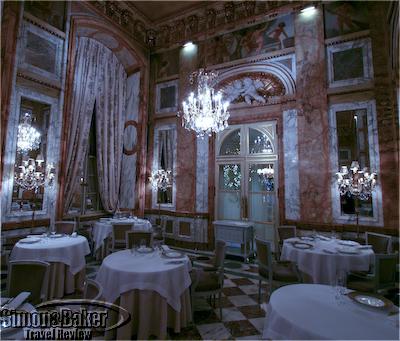
The dining room at Les Ambassadeurs
Over the years the marble filled historic building has been well maintained. Our spacious and handsome Presidential Suite looked onto Rue de l’Arcade and a building that may have been part of the embassy complex. We liked the well known entrance from the Place de la Concorde and another more discreet entrance on Rue de l’Arcade leading to Rue Saint Honore, a popular shopping street. As guests we had access to a fitness center, two restaurants and a bar within the hotel; we could also walk for exercise and dine at one of the myriad restaurants within a short distance of the hotel.
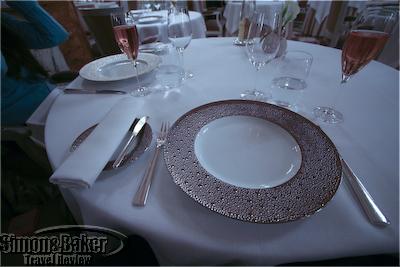
A place setting at Les Ambassadeurs
For years Les Ambassadeurs, the hotel’s gourmet restaurant, has stood out among the thousands of dining venues of the city. Its beautiful dining room and prized location on the Place de la Concorde have been among its attractions along with talented chefs and capable restaurant staff. During our stay at the hotel we dined at Les Ambassadeurs, which had undergone a change in management and chef, to rediscover the restaurant.
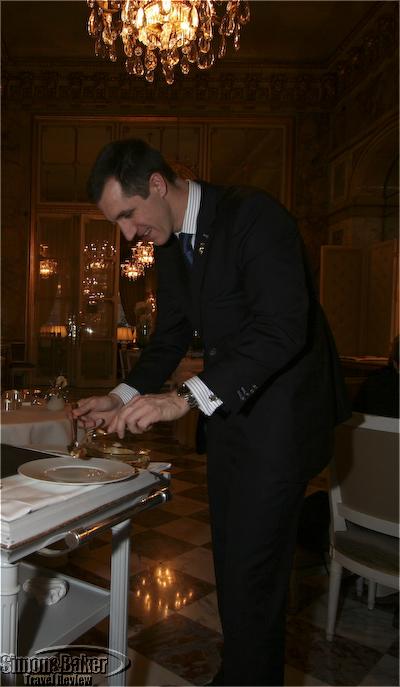
Pierre Jung, the restaurant manager at Les Ambassadeurs
We were pleasantly surprised to see Pierre Jung, the new manager and a familiar face. We knew him from his time at the well known Senderens restaurant in the nearby Place de la Madeleine. Christopher Hache, the promising new young chef, who we met briefly that day, also had experience at Senderens (and as it was formerly known Lucas Carton). Our delicious and well served tasting menu was a success. We plan to return to the restaurant when next we are in Paris.
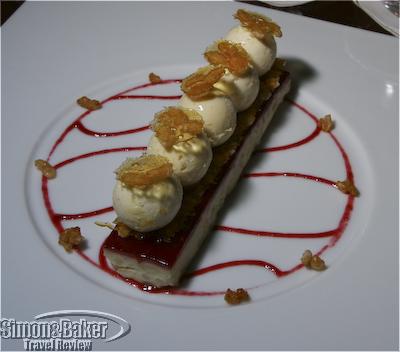
Dessert at Les Ambassadeurs
We thoroughly enjoyed our most recent stay at the Hotel de Crillon, especially our Presidential Suite and indulgent meal at Les Ambassadeurs. Visit the Simon & Baker Travel Review for information about the restaurant Les Ambassadeurs and Hotel de Crillon in Paris, France.
Our most recent visit to Helene Darroze restaurant in Paris, France
By Elena del Valle
Photos by Gary Cox

The entrance to Hélène Darroze
For years we had been fans of Chef Hélène Darroze, an up and coming chef with an adventurous touch. It had been nearly four years since our last visit and we wondered what was new at her Latin Quarter restaurant in Paris, France. When we visited Paris most recently we made time to sample the restaurant’s Lunch and Tasting menus.
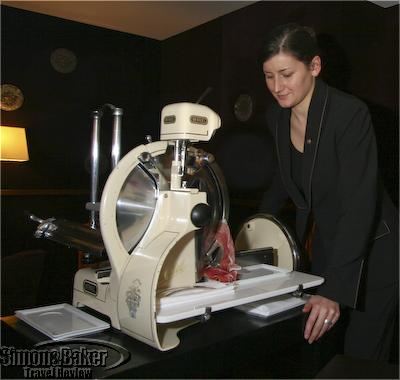
A pre-appetizer sliced at our table was a favorite
We discovered a very different restaurant from the one we used to visit. Where there used to be an a la carte and special menus now there were only two basic dining options. There was a Lunch Menu for 52 euros or 65 euros with two glasses of wine, and a Degustation Menu priced at 125 euros or 175 euros with four glasses of wine.
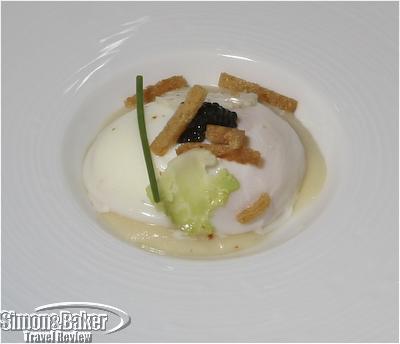
French caviar with cauliflower mousse from Britanny
The first day we dined there we had the Lunch Menu: Le caviar de France mousseline de chou-fleur de Bretagne en gelée iodée, tartare de noix de coquilles Saint-Jacques de Port en Bessin au corail d’oursin; Le homard bleu cuit à la nacre,royale de potimarron, miettes de châtaigne, cappuccino de Parmesan Reggiano; Le chipiron de ligne de Saint-Jean de Luz fine raviole aux verts de blette et olives Taggiasche, chorizo, réduction à l’encre perlée d’huile d’olive, émulsion d’ail rose; Le foie gras de canard des Landes de chez Dupérier grillé au feu de bois, betteraves glacées, jus de riquette à l’estragon; La sole de petit bateau filet tartiné de limequat confit, sudachi, salsifis et coquillages, émulsion à la citronnelle; Le cochon d’Ibérico Bellota Carré et pluma, chou de Bruxelles, pomme Rubinette et chasselas de Moissac caramélisés, jus de déglaçage; L’ananas, la vanille et la noix de coco dans une version sucrée de la pina collada; and Le chocolat Manjari de Madagascar ganache, crème brûlée au calamansi confit, crumble au cacao.

A favorite Bellota pork dish
On the last day of the year we had the Tasting Menu: Le caviar de France mousseline de chou-fleur de Bretagne en gelée iodée, tartare de noix de coquilles Saint Jacques de Port en Bessin aux coraux d’oursin (Caviar from France iodized Brittany cauliflower mousseline, tartar of Saint-Jacques scallops from Port en Bessin with sea urchin); Le homard bleu cuit à la nacre, royale de potiron, miettes de chataîgne, capuccino de parmesan Reggiano (Blue lobster slightly seared, winter squash royale, chestnut crusts, Parmigiano Reggiano cappuccino); Le chipiron de Saint-Jean-de-Luz fines ravioles aux verts de blette et olives Taggiasche, chorizo, réduction à l’encre perlé d’huile d’olive, crème d’ail rose (Line caught calamari from Saint-Jean de Luz ravioli with chard and Taggiasche olives, chorizo, ink reduction with olive oil, pink garlic emulsion); Le foie gras de canard des Landes de chez Dupérier grillé au feu de bois, betteraves glacées, jus de roquette à l’estragon (Dupérier’s duck foie gras grilled on wood fire, glazed beets, riquette jus with tarragon); La sole de petit bâteau filet tartiné de limequat confit, sudashi, salsifis et coquillages, émulsion à la citronnelle (Sole fillet, spread with confit limquat, sudachi, salsify and shellfish, lemon grass foam); Le chevreuil filet rôti au poivre long, côtelette juste saisie, chou de Bruxelles, pomme Rubinette et chasselas de Moissac caramélisés; La poire Comice pochée, panacotta parfumée au gingembre confit, biscuit clafoutis, granité à la poire (Pina colada coconut crisps, lemon jelly, Bombay curry, Tahitian vanilla ice-cream); and Le chocolat Manjari de Madagascar ganache, crème brûlée au kalamansi confit, crumble au cacao (Manjari chocolate from Madagascar ganache, confit Calamansi crème brûlée, cocoa crumble).

The sommelier pouring our champagne
Céline Strenta, the sommelier, selected three young wines to accompany our meal Pacherenc du Vic Bihl 2009, Vouvray sec 2007 “Le Mont” Domaine Huet and Bergerac 2008 “Clos des Verdot” David Fourtour. We liked the red best.
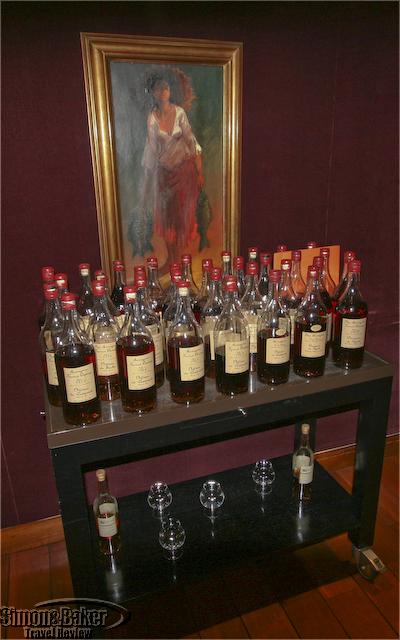
The armagnac cart
Both times the upstairs gourmet dining room (the restaurant offered two additional dining venues on the ground floor) at the restaurant Helene Darroze where we had lunch was near full. The meals were satisfying, well prepared and well served. The English speaking staff that looked after us were helpful and pleasant and and the overall dining experience was worth repeating. Restaurant Hélène Darroze, 4 rue d’Assas, 75006, Paris, France, Telephone + 33 42 22 00 11, www.helenedarroze.com, Email reservation@helenedarroze.com.
Le Chiberta, a restaurant find near the Champs Elysees
By Elena del Valle
Photos by Gary Cox
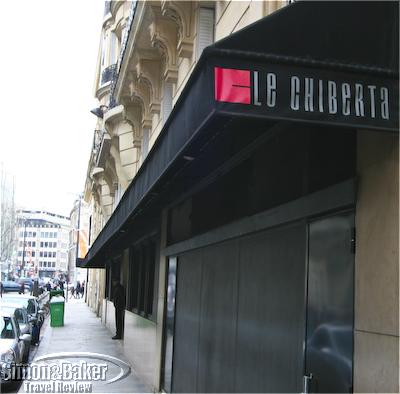
A street view of Le Chiberta
It was lunch time on a quiet winter day when we first discovered Le Chiberta. As we entered the restaurant through twin glass doors we encountered welcoming faces. A young lady took our coats and within minutes we were seated at a comfortable corner table near the entrance, next to a window.
Although the simple decor in black and charcoal gray revealed little about the food we might expect we had high hopes for the restaurant, owned by Guy Savoy, one of the city’s best known chefs. In the past, we had dined at Restaurant Guy Savoy, the chef’s eponymous restaurant, with quite positive results and were looking forward to trying out Le Chiberta, a budget friendly alternative.

Our server Francois
We were the first guests to arrive at the restaurant with capacity for 80 situated in a quiet small street very near the famed Champs Elysees in Paris, France. Slowly others from near and far arrived. We shared our section of the dining room (there were several sections) with three tables of two and were looked after mainly by Francois, an English speaking server who was friendly and very helpful.
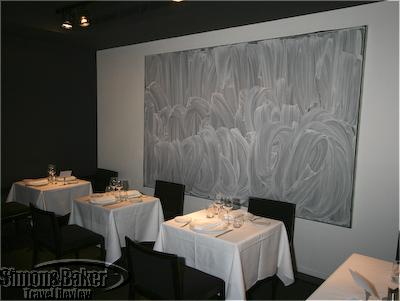
The artwork added texture to the decor
At our table the only decorations were the meal service and a simple steel colored salt and pepper set. While we awaited our lunch we observed the interior décor, which was somewhat similar to the familiar Guy Savoy sister restaurant. It was the work of Jean-Michel Wilmotte and was meant to emulate an informal club style. Across from our table there was an over large oil painting. We noticed bottle-lined walls in the adjoining dining room and hallway. These were understated and juxtaposed with contemporary works of art by Bertrand Lavier and Gérard Traquandi.
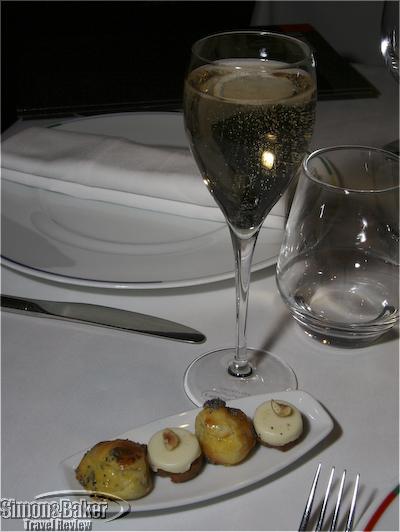
Champagne and amuse bouche bites
We began our lunch with a glass of Laurent Perrier Champagne. Soon two amuse bouche bites appeared and shortly after that a bread basket with two types of bread and Saint Malo seaweed butter arrived. We left our selections in the hands of the chef who delivered a well balanced and refined meal. He served: Amuse bouche Crème de carotte à la citronnelle-gingembre gambas rôtie aux épices douces; Terrine de foie gras de canard artichaut et figue royale de foie gras chutney de kumquat et mangue; Filet de daurade royale à la plancha écrasée de potimarron, salade amère jus au sarrasin; Suprême de colvert rôti, cuisse confite fricassée d’épinards, artichauts et trompettes de la mort jus salmis; Brie truffé et mascarpone salade de mâche; Tout clémentine; and Le cube chocolat-café. It was served with white: Beaune Longbois 2008 Domaine Berthelemot; Condrieu Chauson 2007; and Domaine du Monteillet, S Montez wines; and red wines: Château L’Argilus du Roi 2007 Saint-Estèphe and a dessert wine, Maury Mas Amiel vintage 2008.
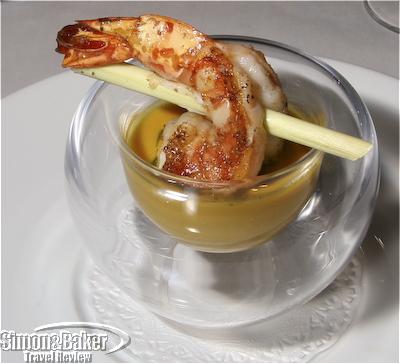
The prawn and ginger carrot soup
The first course, a favorite and we learned after we finished every bite, one of the restaurant’s specialties, featured a carrot ginger soup in a glass bowl with a single prawn skewered by a lemon grass stick. The next course was foie gras with artichoke and fig in the middle, accompanied by warm foie gras cream served in a small glass with kumquat and mango chutney. There was additional chutney with a tiny bite of sweet tuille to accompany the dish; warm toast were served with it. It was served with a citrusy light white wine.
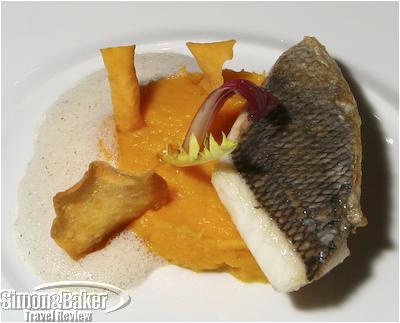
The dorade with mashed pumpkin
Dorade fish (a favorite) served with mashed pumpkin and a foam came next. It was accompanied by an oaky white wine. Wild duck from the forest served very rare with marvelous mushrooms and a little spinach came next. It was accompanied by a lovely 2007 Saint Estephe red. Truffled brie with home made truffle filling served with black truffle shavings and a salad of baby mache with a vinegar dressing was the perfect follow up to the wild duck. A tangerine palate cleanser followed the cheese and a wonderful chocolate cube and coffee ice cream dessert completed the meal. It was served with a velvety red dessert wine.
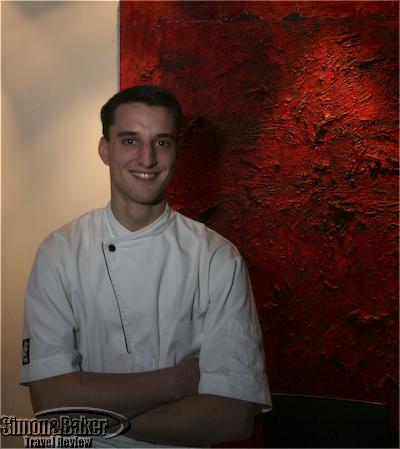
The chef at Le Chiberta the day we visited the restaurant
It can be challenging to find a satisfying meal without spending a fortune in that very touristy area of Paris. Le Chiberta, established in 2004, combined a desirable location with excellent food and attentive service in a pleasant setting. Kudos to Chef Guy Savoy and Stéphane Laruelle, Le Chiberta’s executive chef.
Le Chiberta (Le Chiberta, 3, rue Arsene Houssaye, 75008, Paris France, Telephone +33 1 53 53 42 00, Fax +33 1 45 62 85 08, www.lechiberta.com, chiberta@guysavoy.com) is now part of very our short list of options anytime we are in the mood for well a prepared yet unpretentious meal in area of the Champs Elysees.
OtterBox Defender kept our iPad safe on safari
By Gary Cox

In the bush with our iPad on the hood of the Range Rover at Africa House
Our iPad has proven to be an excellent tool when traveling to process email, create documents and preview photographs. Among the wide variety of sleeves, covers and folios available for it, the OtterBox Defender stood out with its focus on protecting the fragile device in rugged environments. We were departing to spend several weeks in the game reserves of South Africa and wanted a case that was functional and could provide protection during the transfers over dirt roads and rough handling by porters.
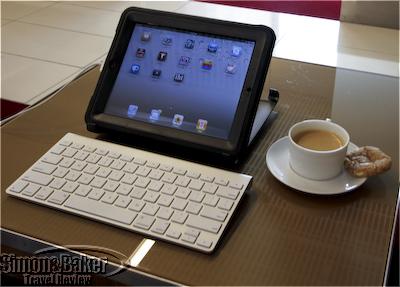
During a layover in the Air France lounge
Assembly was relatively easy, although we did not use the clear plastic screen cover, having already installed one made by a different manufacturer the day we bought the iPad. The installation video on the OtterBox website was helpful and better than the tiny illustrations on the package cover. The cleaning cloth is also a nice bonus and comes in handy when fingerprints are visible after a hard day of use. Disassembly with the third party screen cover can be challenging and we do not plan on putting the cover on and off frequently.
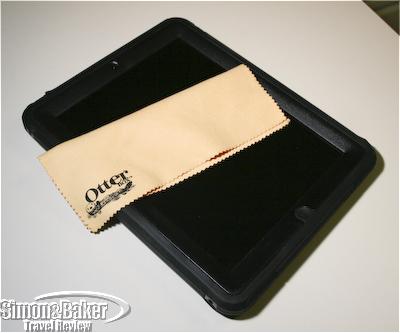
A cleaning cloth was included with the Defender
Once the Defender was assembled, the iPad feels heavier, but simultaneously easier to grip and more solid in general. All of the necessary buttons and ports are easily accessible either right through the cover or by opening a tiny flap in the case of the headset jack. With the case installed, it is more comfortable to set the device down on a table or other hard surface without concern for the iPad. There is a small panel that can be removed to allow access to the interface port for charging and connecting to external devices.
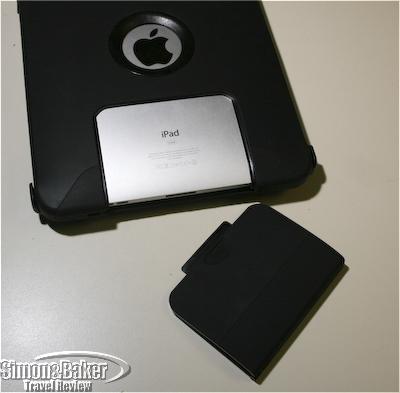
The case with the interface panel removed
A favorite feature is the hard shell cover which can be snapped on to protect the face of the device, or snapped on the back of the iPad and out of the way. It also doubles as a stand to support the iPad at a comfortable viewing angle. With the Bluetooth keyboard connected and the iPad resting on its stand, editing a document or navigating the web is as efficient as using a laptop computer. The stand is sturdy and secure enough to allow fingertip control, an essential function of the device.
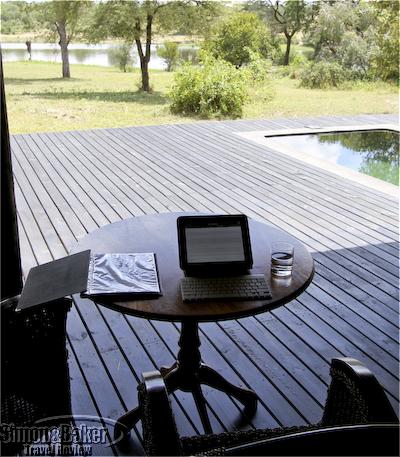
Working at Chitwa Chitwa lodge with the iPad on the stand
Turning the iPad off and attaching the shell over the face allowed us to pack the device into our camera box without worrying about it being damaged, scratched or accidentally turned on and running down the batteries. We picked up a sleeve for the keyboard from WaterField designs in San Francisco. This combination was low profile and kept our equipment in top shape throughout our lengthy journey.
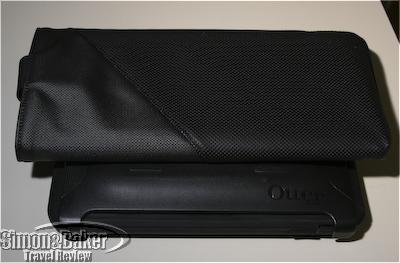
The iPad with the cover installed and keyboard in its sleeve
The case kept our first generation iPad safe and secure throughout our safari travels and for daily use at home as well. With the improved grip and rubberized exterior the iPad is friendly to glass tabletops and when passed from one person to another. The exterior is attractive and consistent with the iPad design. We plan to leave the iPad in the OtterBox Defender case (Otter Products LLC, 1 Old Town Sq #303, Fort Collins, CO 80524 888-695-8820, +1 970-493-8446, http://www.otterbox.com/, customer.service@otterbox.com) for the foreseeable future.
My new mobile phone with personal WiFi
Article and photos by Joachim Castellano
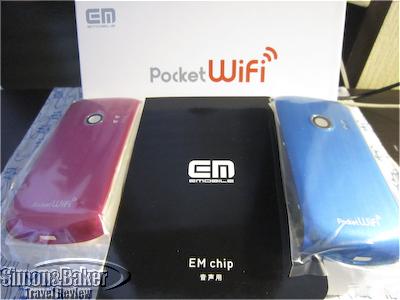
The Emobile Pocket WiFi-S package and covers
The Emobile Pocket WiFi-S (model number S31-HW) is a versatile Android-enabled smartphone that stands out thanks to a superb feature: with a touch of a button the user can create a personal Wi-Fi hotspot. In Japan, the only place where it was available when I tested it for 42 days, locating public Wi-Fi can be very difficult. Having my own Wi-Fi means I never have to worry about finding a wireless network that connects with my laptop, iPad, or gaming device. I can connect up to five different gadgets simultaneously.
In practice the wireless performance of this 105 gram phone manufactured by Huawei Technologies of China and distributed by Emobile of Japan wasn’t as fast as the Emobile’s Wi-Fi only Pocket WiFi (D25-HW) model. At times, the plastic and glass Pocket WiFi-S’ speed noticeably struggled in the slow lane; that was likely when Emobile’s network traffic was particularly clogged.
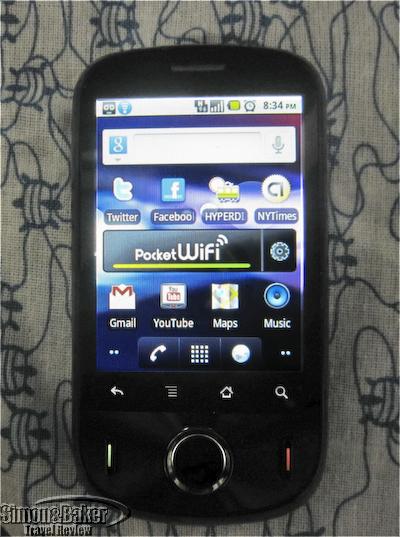
The front of the Emobile Pocket WiFi-S
What I lost in speed, however, I gained with the versatility of a full-fledged smartphone. I was able to make phone calls, browse the web, send and receive email, consume media, and navigate with GPS just like with any standard smartphone on the market. Also, because it runs Google’s Android mobile operating system, I was able to download apps from the Android App Market. For example, train schedule and route apps like Hyperdia or Jorudan helped me navigate the labyrinth of Japanese rail. I downloaded one of these apps and recycled the wrinkling pocket rail guide I had been toting around.
The smartphone, 54.8 × 104 × 13.5 millimeters in size, ran Google’s Android 2.2 operating system with a menu system in English and Japanese. The wireless (b/g) WiFi hotspot was capable of connecting up to five devices at HSPA 7.2Mbps down/5.8Mbps up connection speeds. It included a rear-facing 3.2 megapixel photo and video camera, 2.9 inch touchscreen, built-in speaker, 3.5 mm audio jack, Bluetooth 2.1, and had 512MB of memory with expandable memory through a microSD slot.
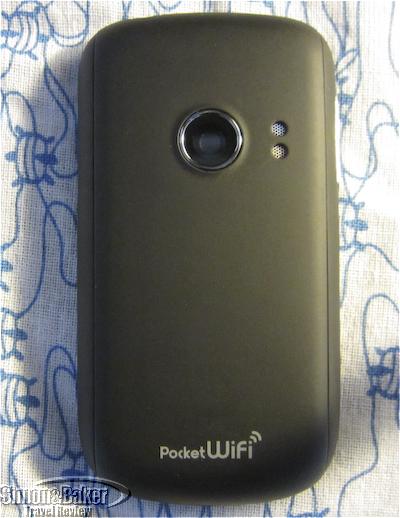
The back of the Emobile Pocket WiFi-S
The phone I tested had a battery length of five hours of talk time, four hours of standard usage, and 240 hours of standby. It came with one battery pack, AC adaptor, USB cable, microSD card, and three color covers, black, blue, and pink. The retail price was 19,800 Japanese yen ($235) as part of a two year contract, and phone and data plan costing about 8,000 Japanese yen ($95) per month.
While not as slick and graceful as its fruity and shiny rival, the Pocket WiFi-S does have that personal Wi-Fi network trick up its sleeve.


